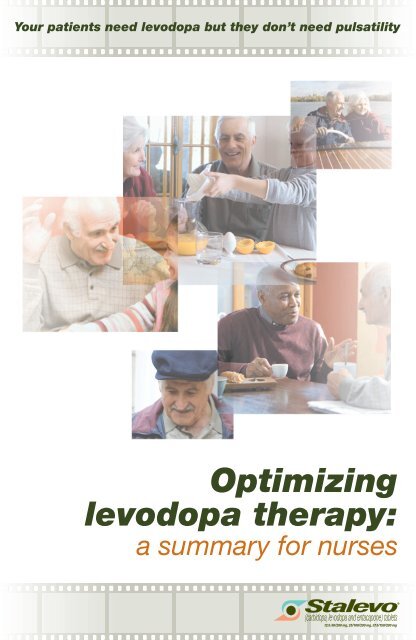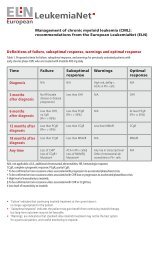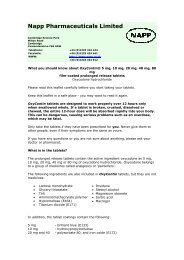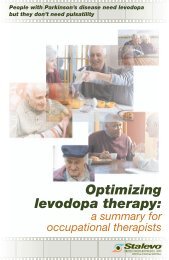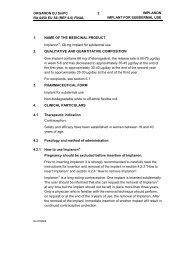Levodopa - epgonline.org
Levodopa - epgonline.org
Levodopa - epgonline.org
Create successful ePaper yourself
Turn your PDF publications into a flip-book with our unique Google optimized e-Paper software.
ENT416_NURSES LEAVEPIECE.qxd 2/10/06 14:08 Page 1<br />
Your patients need levodopa but they don’t need pulsatility<br />
Optimizing<br />
levodopa therapy:<br />
a summary for nurses
ENT416_NURSES LEAVEPIECE.qxd 2/10/06 14:08 Page 3<br />
Parkinson’s disease: a common<br />
neurological disorder<br />
• Parkinson’s disease (PD) is a common neurological disease, affecting<br />
more than four million people worldwide. The incidence rates of PD are<br />
8–18 per 100,000 person–years, and the prevalence has been estimated<br />
at 1% in people over 60 years of age 1<br />
• The symptoms of PD are different for each individual, vary<br />
in severity and may change over time. The most common<br />
symptoms are motor and include muscle rigidity,<br />
resting tremor and slowness of movement<br />
(bradykinesia). Other motor features include<br />
loss of balance, a shuffling gait and lack of facial expression<br />
• Non-motor symptoms, which may precede motor symptoms in the<br />
development of PD, include depression, pain, fatigue, facial flushing,<br />
sweating, disordered sleep patterns and abnormal skin sensations such<br />
as tingling<br />
• Due to the wide range of symptoms, the treatment of PD is best delivered<br />
by a multidisciplinary team, including doctors, nurses, physiotherapists<br />
and pharmacists<br />
• Recent advances in medications mean that we now have better control<br />
over the condition than ever before. Optimizing pharmacological therapy<br />
will improve functionality and quality of life for patients with PD<br />
Stages of Parkinson’s disease<br />
EARLY-STAGE:<br />
• Usually 3–5 years from diagnosis<br />
• Moderate motor symptoms<br />
• Excellent response to medication<br />
• Near-normal functioning<br />
MID-STAGE:<br />
• Usually 5–10 years from diagnosis<br />
• Motor complications (50–70% of patients) vary in severity<br />
• Difficulty initiating movement and loss of balance<br />
• Medication is still efficacious<br />
• Help is needed with normal daily activities<br />
LATE-STAGE:<br />
• Usually over 10 years from diagnosis<br />
• Response to medication is erratic, resulting in severe fluctuations<br />
• Difficult to control symptoms with medication and side-effects are often more<br />
challenging than basic symptoms<br />
• Considerable and frequent need for assistance in daily activities<br />
[1] de Lau and Breteler. Lancet 2006; 5: 525–35
ENT416_NURSES LEAVEPIECE.qxd 2/10/06 14:08 Page 4<br />
Parkinson’s disease: the<br />
challenge of treatment and<br />
the nurse’s role<br />
• PD is a complex condition that requires careful monitoring and care from<br />
a number of different healthcare stecialists which comprise the<br />
multidisciplinary team<br />
• As with all neurological conditions, medication for patients with PD must<br />
be carefully managed to ensure maximum quality of life<br />
• The nurse, who sees patients in hospital, at clinics and in their own<br />
homes, is uniquely placed to monitor the effectiveness of changes in<br />
medication and treatment, and to provide information and education<br />
Important aspects of the nurse’s role within the<br />
Parkinson’s healthcare team include…<br />
• Awareness and treatment of the full range of symptoms seen in PD<br />
• Helping to maintain contact between the patient and the rest of the<br />
healthcare team<br />
• Offering support and reassurance to patients and caregivers<br />
• Setting reasonable expectations for therapy including the development of<br />
motor complications and side-effects<br />
• Initiating and managing change, and evaluating care<br />
• PD nurses can provide specialist advice to GPs and train other nurses
ENT416_NURSES LEAVEPIECE.qxd 2/10/06 14:08 Page 5<br />
<strong>Levodopa</strong>: the most effective<br />
therapy for Parkinson’s disease<br />
• As PD is caused by reduced levels of dopamine in the brain, replacing<br />
dopamine with levodopa (a precursor to dopamine) or mimicking its<br />
action with dopamine agonists are key approaches to treatment<br />
• Patients have fewer symptoms and function better with levodopa than<br />
with other dopaminergic therapies<br />
Mean change from baseline<br />
–16<br />
–14<br />
–12<br />
–10<br />
–8<br />
–6<br />
–4<br />
–2<br />
0<br />
Better overall<br />
function* with<br />
levodopa vs<br />
the dopamine<br />
agonist<br />
pramipexole<br />
over 4 year<br />
follow-up 1<br />
2<br />
4<br />
0 6 12 18 24 30 36 42 48<br />
Months from randomization<br />
<strong>Levodopa</strong>/DDCI Pramipexole<br />
n=301; 72% of<br />
pramipexole group<br />
required open-label<br />
levodopa with a<br />
mean total daily<br />
levodopa dosage<br />
434 ± 498 mg/day.<br />
DDCI=dopa-decarboxylase inhibitor<br />
• The superiority of levodopa to dopamine agonists in patient function<br />
and side-effects has been repeatedly demonstrated 1–3<br />
– Patients with levodopa experience better overall function*, activities<br />
of daily living and motor function compared with those receiving the<br />
dopamine agonists pramipexole, pergolide and ropinirole<br />
– <strong>Levodopa</strong> therapy has a lower incidence of side-effects than dopamine<br />
agonists. Common side-effects associated with both levodopa and<br />
dopamine agonists include nausea, vomiting and postural hypotension.<br />
However, psychiatric symptoms such as hallucinations and psychosis are<br />
more common with agonists than with levodopa and are particularly prone<br />
to occur in elderly or patients with cognitive difficulties. Other adverse<br />
events such as impulse control disorders, edema and fibrosis have been<br />
associated with dopamine agonist use, although these are relatively rare
ENT416_NURSES LEAVEPIECE.qxd 2/10/06 14:08 Page 6<br />
• Most side-effects experienced with levodopa can be managed<br />
conservatively. People who experience nausea and vomiting when<br />
therapy is first initiated usually find this improves without intervention<br />
*Improvements in overall function have been based on the Total Unified Parkinson’s Disease Rating<br />
Scale (UPDRS). The UPDRS score is a standardized measure of patients’ motor abilities, activities<br />
of daily living and mental abilities.<br />
[1] Parkinson Study Group. JAMA 2000; 284: 1931–8; [2] Oertel et al. Mov Disord 2006; 21:<br />
343–53; [3] Rascol et al. N Engl J Med 2000; 342: 1484–91<br />
Wearing-off is the greatest<br />
concern patients have with<br />
traditional levodopa therapy<br />
Wearing-off occurs when any of the signs or symptoms of PD emerge before<br />
the next dose of PD medication is due 1<br />
• Wearing-off is the number one issue patients have with levodopa therapy 2 ,<br />
and can lead to unfounded patient concern<br />
• Traditional levodopa therapy results in the pulsatile stimulation of<br />
dopamine receptors, which is associated with the development of motor<br />
complications such as wearing-off and dyskinesia<br />
[1] Stacy et al. Mov Disord 2005; 20: 726–33; [2] Lieberman and Vijay. Eur J Neurol 2004; 11:<br />
S36–182
ENT416_NURSES LEAVEPIECE.qxd 2/10/06 14:08 Page 7<br />
The typical pattern of wearing-off<br />
• Wearing-off:<br />
– Is associated with motor symptoms such as tremor, rigidity and muscle<br />
cramps, and non-motor symptoms such as anxiety, fatigue and<br />
slowness of thinking<br />
– Occurs in up to 40% of patients within 2 years 1<br />
– Is often detected later than it should be:<br />
• Patients often take a dose of levodopa just before they see their<br />
nurse or doctor so their symptoms are well-controlled<br />
• Doctors often focus on more visible concerns<br />
• Patients might not link subtle wearing-off symptoms to being<br />
associated with their PD (e.g. anxiety, pain)<br />
• Anxiety related to being told of disease progression may prevent<br />
patients from openly discussing their symptoms with their doctor<br />
[1] Parkinson Study Group. JAMA 2000; 284: 1931–8
ENT416_NURSES LEAVEPIECE.qxd 2/10/06 14:08 Page 8<br />
Recognizing the end result of<br />
pulsatility: wearing-off<br />
Nearly half of all patients reporting wearing-off are not diagnosed 1<br />
48%<br />
Diagnosed by patients<br />
questionnaire only<br />
Diagnosed by physician<br />
questionnaire<br />
52%<br />
Questions filled out individually by 300 patients and examining physicians. In some instances,<br />
wearing-off diagnosed by the physician was also diagnosed by the patient.<br />
[1] Stacy et al. Mov Disord 2005; 20: 726–33
ENT416_NURSES LEAVEPIECE.qxd 2/10/06 14:08 Page 9<br />
Asking patients about their<br />
symptoms will improve<br />
recognition of wearing-off<br />
• The wearing-off symptom card lists nine symptoms that commonly occur<br />
during wearing-off as a result of pulsatile dopaminergic stimulation,<br />
including tremor, slowness in movement, changes in mood, and anxiety or<br />
panic attacks 1<br />
• This was designed to help healthcare workers and patients to rapidly and<br />
effectively identify wearing-off<br />
The wearing-off symptom card<br />
Symptom Experience symptoms Usually improves after<br />
my next dose<br />
1. Tremor<br />
2. Any slowness in movement<br />
3. Mood changes<br />
4. Any stiffness<br />
5. Pain / aching<br />
6. Reduced dexterity<br />
7. Cloudy mind / slowness<br />
of thinking<br />
8. Anxiety / panic attacks<br />
9. Muscle cramping<br />
• It is also good practice to encourage<br />
patients to keep a diary of their symptoms<br />
for discussion with their healthcare team<br />
Nurses, in particular, are well placed to help patients<br />
identify their wearing-off symptoms<br />
[1] Stacy et al. Mov Disord 2005; 20: 726–33
ENT416_NURSES LEAVEPIECE.qxd 2/10/06 14:08 Page 10<br />
Complications of levodopa are<br />
due to pulsatile delivery<br />
• Pulsatile delivery of levodopa leading to abnormal variations in blood<br />
levels is believed to lead to physiological changes that may result in motor<br />
complications such as wearing-off and dyskinesia 1<br />
• Improving the way levodopa is given at an early stage may reduce the<br />
development of motor complications such as wearing-off<br />
[1] Stocchi. Parkinsonism Relat Disord 2003; 9: S73–81<br />
However, most therapeutic<br />
strategies targeting wearing-off<br />
fail to address pulsatility<br />
• Steady plasma levels of levodopa may be provided by a constant infusion<br />
of levodopa; however, its use is cumbersome and impractical<br />
• Other commonly used methods include increasing the dose of levodopa<br />
or giving smaller, more frequent doses (fractionation); using controlledrelease<br />
preparations which have a longer duration of action, or using<br />
dopamine agonists<br />
Modifying the dose<br />
Plasma levels with titrated levodopa/DDCI 1<br />
<strong>Levodopa</strong> plasma levels<br />
(ng/mL)<br />
4000<br />
3000<br />
2000<br />
1000<br />
0<br />
Dose<br />
DDCI=dopa-decarboxylase inhibitor<br />
• Does nothing to improve the short, 1.5-hour half-life of levodopa
ENT416_NURSES LEAVEPIECE.qxd 2/10/06 14:08 Page 11<br />
Controlled-release delivery<br />
Plasma levels with controlled-release<br />
levodopa/DDCI 2<br />
<strong>Levodopa</strong> plasma levels<br />
(n g/mL )<br />
4000<br />
3000<br />
2000<br />
1000<br />
0<br />
Full Half Full Half<br />
Dose<br />
DDCI=dopa-decarboxylase inhibitor<br />
• Leads to erratic absorption of levodopa 2<br />
Dopamine agonist supplementation<br />
Plasma levels with dopamine agonists<br />
<strong>Levodopa</strong> plasma levels<br />
(ng/mL)<br />
1000<br />
500<br />
0<br />
<strong>Levodopa</strong><br />
<strong>Levodopa</strong> + DA<br />
0 4 8<br />
Hours<br />
DA=dopamine agonist<br />
• Does not affect the pharmacokinetics of levodopa 3<br />
• However, none of these therapeutic strategies affect the pulsatility of<br />
levodopa, and so do not address the underlying cause of wearing-off<br />
[1] Nutt. Adv Neurol 1996; 69: 493–6; [2] Olanow et al. Mov Disord 2004; 19: 997–1005;<br />
[3] Fariello. Drugs 1998; 55 (Suppl 1): 10–6
ENT416_NURSES LEAVEPIECE.qxd 2/10/06 14:08 Page 12<br />
Stalevo ® : more continuous<br />
levodopa for less pulsatility<br />
• Stalevo (levodopa/carbidopa/entacapone) is an enhanced levodopa that<br />
improves the delivery of dopamine to the brain<br />
Stalevo provides more consistent delivery 1<br />
5000<br />
<strong>Levodopa</strong>/DDCI + entacapone<br />
<strong>Levodopa</strong>/DDCI + placebo<br />
<strong>Levodopa</strong> plasma levels (ng/mL)<br />
4000<br />
3000<br />
2000<br />
1000<br />
0<br />
Dose Dose Dose Dose Dose<br />
DDCI=dopa-decarboxylase inhibitor<br />
18 patients on oral levodopa dosed 3, 4 or 5 times/day had entacapone 200 mg administered with<br />
each levodopa dose for 4 weeks. Plasma levels were taken over 12 hours before and after addition<br />
of entacapone. Plasma levels for one patient dosing q3h.<br />
• In patients with wearing-off, Stalevo 2–8 :<br />
– Improves overall patient function (represented in the figure opposite by<br />
UPDRS scores*), activities of daily living (ADL) and motor scores<br />
versus traditional levodopa<br />
– Furthermore, Stalevo allows the preservation of function (UPDRS*)<br />
and levodopa dose for at least the 3 years following initiation. In<br />
contrast, the use of traditional levodopa and the dopamine agonist<br />
pramipexole has been shown only to delay the progression of PD<br />
rather than stabilize it<br />
– Increases the time that symptoms are well-controlled (‘on’ time) by<br />
up to 1.7 hours versus baseline<br />
– Long-term trials indicate that using Stalevo at an early stage confers<br />
additional sustained benefits in symptom control which are<br />
maintained for at least 5 years 8<br />
• Stalevo is well-tolerated, with a favourable side-effect profile
ENT416_NURSES LEAVEPIECE.qxd 2/10/06 14:08 Page 13<br />
Stalevo improves patient function 2<br />
<strong>Levodopa</strong>/DDCI + placebo<br />
M ean improvement from baseline (% )<br />
20<br />
15<br />
10<br />
5<br />
0<br />
Stalevo (<strong>Levodopa</strong>/DDCI + entacapone)<br />
P
ENT416_NURSES LEAVEPIECE.qxd 2/10/06 14:08 Page 14<br />
Upgrading to Stalevo ®<br />
• Patients can be switched directly to an equivalent dose of levodopa if<br />
they are:<br />
– Experiencing symptom re-emergence<br />
– Taking ≤ 800 mg/day levodopa<br />
– Experiencing no dyskinesia<br />
• When initiating Stalevo in a patient currently treated with<br />
levodopa/benserazide, discontinue dosing of levodopa/benserazide the<br />
previous night and start Stalevo the next morning<br />
<strong>Levodopa</strong>/carbidopa Switch Stalevo dose<br />
50 mg<br />
50 mg<br />
100 mg<br />
100 mg<br />
+ 150 mg<br />
150 mg<br />
Stalevo comes in three convenient dose strengths<br />
• Each strength has a 4:1 ratio of levodopa to carbidopa, plus 200 mg of<br />
entacapone<br />
• The only way to provide dopa-decarboxylase and catechol-Omethyltransferace<br />
inhibition in a single tablet formulation<br />
• When initiating Stalevo in a patient currently treated with<br />
levodopa/benserazide, discontinue dosing of levodopa/benserazide the<br />
previous night and start Stalevo the next morning
ENT416_NURSES LEAVEPIECE.qxd 2/10/06 14:08 Page 15
ENT416_NURSES LEAVEPIECE.qxd 2/10/06 14:08 Page 16<br />
Stalevo (levodopa / carbidopa / entacapone)<br />
PRESCRIBING INFORMATION<br />
Indications: Stalevo is indicated for the treatment of patients with Parkinson’s disease and end-of-dose motor<br />
fluctuations not stabilised on levodopa/dopa decarboxylase (DDC) inhibitor treatment. Posology and method<br />
of administration: Each tablet is to be taken orally either with or without food (see section 5.2). One tablet<br />
contains one treatment dose and the tablet may only be administered as whole tablets. The optimum daily<br />
dosage must be determined by careful titration of levodopa in each patient. The daily dose should be preferably<br />
optimized using one of the three available tablet strengths (50/12.5/200 mg, 100/25/200 mg or 150/37.5/200 mg<br />
levodopa/carbidopa/entacapone). Patients should be instructed to take only one Stalevo tablet per dose<br />
administration. Patients receiving less than 70–100 mg carbidopa a day are more likely to experience nausea<br />
and vomiting. While the experience with total daily dosage greater than 200 mg carbidopa is limited, the<br />
maximum recommended daily dose of entacapone is 2000 mg and therefore the maximum Stalevo dose is 10<br />
tablets per day.<br />
How to transfer patients not currently treated with entacapone to Stalevo: Initiation of Stalevo may be<br />
considered at corresponding doses to current treatment in some patients with Parkinson’s disease and end-ofdose<br />
motor fluctuations, who are not stabilised on their current standard release levodopa/DDC inhibitor<br />
treatment. However, a direct switch from levodopa/DDC inhibitor to Stalevo is not recommended for patients<br />
who have dyskinesias or whose daily levodopa dose is above 800 mg. In such patients it is advisable to<br />
introduce entacapone treatment as a separate medication (entacapone tablets) and adjust the levodopa dose if<br />
necessary, before switching to Stalevo. Entacapone enhances the effects of levodopa. It may therefore be<br />
necessary, particularly in patients with dyskinesia, to reduce levodopa dosage by 10-30% within the first days<br />
to first weeks after initiating Stalevo treatment. The daily dose of levodopa can be reduced by extending the<br />
dosing intervals and/or by reducing the amount of levodopa per dose, according to the clinical condition of the<br />
patient. Dosage adjustment during the course of the treatment: When more levodopa is required, an increase<br />
in the frequency of doses and/or the use of an alternative strength of Stalevo should be considered, within the<br />
dosage recommendations. When less levodopa is required, the total daily dosage of Stalevo should be reduced<br />
either by decreasing the frequency of administration by extending the time between doses, or by decreasing the<br />
strength of Stalevo at an administration. If other levodopa products are used concomitantly with a Stalevo tablet,<br />
the maximum dosage recommendations should be followed. Children and adolescents: Not recommended.<br />
Elderly: No dosage adjustment required. Mild to moderate hepatic impairment, severe renal impairment<br />
(including dialysis): Caution advised. Contraindications: Hypersensitivity to active substances or excipients.<br />
Severe hepatic impairment. Narrow-angle glaucoma. Pheochromocytoma. Concomitant use of non-selective<br />
monoamine oxidase inhibitors (e.g. phenelzine, tranylcypromine). Concomitant use of a selective MAO-A<br />
inhibitor and a selective MAO-B inhibitor. Previous history of Neuroleptic Malignant Syndrome (NMS) and/or nontraumatic<br />
rhabdomyolysis. Warnings and precautions: Not recommended for treatment of drug-induced<br />
extrapyramidal reactions. Administer with caution to: patients with severe cardiovascular or pulmonary disease,<br />
bronchial asthma, renal, hepatic or endocrine disease, or history of peptic ulcer disease or of convulsions, or<br />
past or current psychosis; patients receiving concomitant antipsychotics with dopamine receptor-blocking<br />
properties, particularly D2 receptor antagonists; patients receiving other medicinal products which may cause<br />
orthostatic hypotension. In patients with a history of myocardial infarction who have residual atrial nodal, or<br />
ventricular arrhythmias, monitor cardiac function carefully during initial dosage adjustments. Monitor all patients<br />
for the development of mental changes, depression with suicidal tendencies, and other serious antisocial<br />
behaviour. Patients with chronic wide-angle glaucoma may be treated with Stalevo with caution, provided the<br />
intra-ocular pressure is well controlled and the patient is monitored carefully.<br />
Caution when driving or operating machines. Doses of other antiparkinsonian treatments may need to be<br />
adjusted when Stalevo is substituted for a patient currently not treated with entacapone. Rhabdomyolysis<br />
secondary to severe dyskinesias or NMS has been observed rarely in patients with Parkinson’s disease.<br />
Therefore, any abrupt dosage reduction or withdrawal of levodopa should be carefully observed, particularly in<br />
patients who are also receiving neuroleptics. Periodic evaluation of hepatic, haematopoietic, cardiovascular and<br />
renal function is recommended during extended therapy. Undesirable effects: <strong>Levodopa</strong> / carbidopa — Most<br />
common: dyskinesias including choreiform, dystonic and other involuntary movements, nausea. Also mental<br />
changes, depression, cognitive dysfunction. Less frequently: irregular heart rhythm and/or palpitations,<br />
orthostatic hypotensive episodes, bradykinetic episodes (the ‘on-off’ phenomenon), anorexia, vomiting,<br />
dizziness, and somnolence. Entacapone — Most frequently relate to increased dopaminergic activity, or to<br />
gastrointestinal symptoms. Very common: dyskinesias, nausea and urine discolouration. Common: insomnia,<br />
hallucination, confusion and paroniria, Parkinsonism aggravated, dizziness, dystonia, hyperkinesias, diarrhoea,<br />
abdominal pain, dry mouth, constipation, vomiting, fatigue, increased sweating and falls. See SPC for details of<br />
laboratory abnormalities, uncommon and rare events. Presentations and marketing authorization numbers:<br />
Stalevo 50mg/12.5mg/200mg, 30 or 100 tablet bottle, MA numbers: EU/1/03/260/002–003. Stalevo<br />
100mg/25mg/200mg, 30 or 100 tablet bottle, MA numbers: EU/1/03/260/006–007. Stalevo<br />
150mg/37.5mg/200mg, 30 or 100 tablet bottle, MA numbers: EU/1/03/260/010–011. Marketing authorisation<br />
holder and manufacturer: Orion Corporation, Orionintie 1, FIN–02200 Espoo, Finland. Full prescribing<br />
information is available on request. Stalevo is a registered trademark.<br />
This Parkinson’s leaflet information series is sponsored by an<br />
unrestricted educational grant from Novartis and Orion Pharma. Item Date: August 2006


